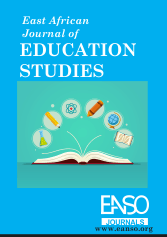Reading Comprehension Activities in the Ugandan English as a Foreign Language Classroom
Abstract
The study examines the reading comprehension activities in the Ugandan English as a Foreign Language (EFL) classroom. It particularly analyses the activities that the learners of EFL participate in as part of their reading comprehension lessons. The study focusses on EFL learners from countries such as Congo, Eritrea, South Sudan, and Ethiopia, among others studying in Ugandan adult language schools. The specific objectives of the study were to identify the reading comprehension activities in the Ugandan EFL classroom and to establish the learners’ response to the reading comprehension activities used in the EFL class. Drawing on the transactional theory, the study analyses the reading comprehension activities and the learners’ response to them. The findings indicate that the most profound activities in the classes were pre-reading activities. In their order of frequency, pre-reading activities were the most profound in the classes observed, followed by while-reading and the post-reading activities, which were the least used. In the classes where reading activities were used, they excited the majority of the EFL learners and they paid attention to the lesson. The learners’ response to the activities was diverse with the majority expressing interest in the activities as others chose not to participate at all. The study recommends the use of more reading comprehension activities especially at the while- and post-reading comprehension stages of the lessons which were lacking in most of the classes observed. It further recommends involving the learners and putting into consideration their views during the identification and selection of reading comprehension activities to ensure their maximum participation in the reading comprehension activities
Downloads
References
Botha, D. Bizos, N., Gains, P., Moris, D., Place, J., and Puwani, H. (2008). National Reading Strategy. [Online] Available at http://www.gov.za/documents
Collins, P. & Gillies, J. (2010). Using Opportunity to Learn and Early Grade Reading Fluency to Measure School Effectiveness in Ethiopia, Guatemala, Honduras, and Nepal. USAID Washington.
Cui YP (2002). “Application of Schema theory in reading comprehension”, Foreign Language Education, 5, 52-57,
Davis, M. (2006). Reading instruction: The two keys. Charlottesville, VA: Core Knowledge Foundation.
Dubeck, M. M., Stern, M. B., and Nabacwa, R. (2021). Learning to Read in a Local Language in Uganda: Creating Learner Profiles to Track Progress and Guide Instruction Using Early Grade Reading Assessment Results. RTI Press Publication No. OP-0068-2106. Research Triangle Park, NC: RTI Press. https://doi.org/10.3768/rtipress.2021.op.0068.2106
Edward, N. S. (2001). Evaluation of a constructivist approach to student induction in relation to students' learning style. European Journal of Engineering Education, 26(4), 429- 40.
Grabe W, (1991), Current developments in second language reading research. TESOL Quarterly, 35 (3), 373-406,
Harmer, J. (2007). The practice of English language teaching. Essex, England: Pearson Education Limited
Herrington, J., Oliver, R., & Reeves, T. C. (2003). Patterns of engagement in authentic online learning environments. Australian Journal of Educational Technology, 19(1), 59-71.
Mohammed & Ofori Amponsah (2018). Predominant factors contributing to low reading abilities of pupils at Elsie Lund Basic School in the Tamale Metropolis, Ghana
Namugenyi, D K K (2018). Balanced reading instruction for improving reading comprehension of bilingual children URI: http://hdl.handle.net/2263/67836
Reschly A L. (2009). Reading and School Completion: Critical Connections and Matthew Effects 67-90 | https://doi.org/10.1080/10573560903397023
Rivers, D. (2010). An exploration of on-task language policy and student satisfaction. ELT Journal, 64(3), 261-271
Marhaeni AAIN (2016) Rosenblatt’s Transactional Theory and its Implementation in the Teaching of Integrated Reading
Ssentanda, M. E. (2014). The Challenges of Teaching Reading in Uganda: Curriculum guidelines and language policy viewed from the classroom. Apples – Journal of Applied Language Studies, Vol. 8,2, 2014, 1– 22
Taglieber, L. K., Johnson, L. L., & Yarbrough, D. B. (1988). Effects of preceding activities on EFL reading by Brazilian college students. TESOL Quarterly, 22(3), 455-471. http://dx.doi.org/10.2307/3587289
Tuttle, H. (2007). Livening up foreign language: Technology enables language learning in authentic situations. Technology & Learning, 28(4), 40-42.
Unrau N & Alvermann D, (2013). Literacies and Their Investigation Through Theories and Models DOI: 10.1598/0710.02
Copyright (c) 2024 Rodney Rugyema

This work is licensed under a Creative Commons Attribution 4.0 International License.




























